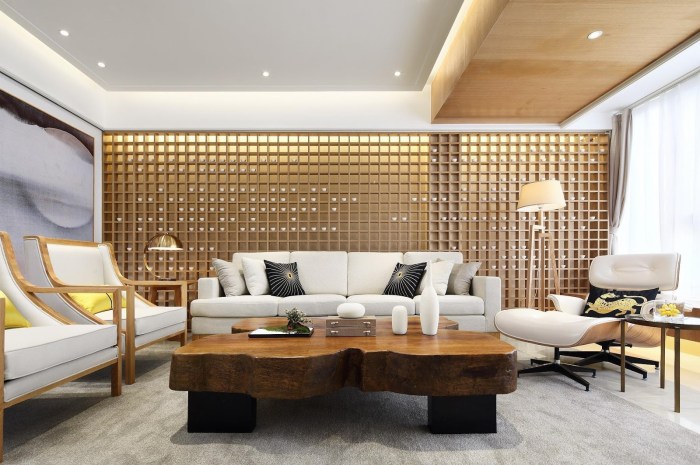How to determine your interior design furniture investment is a crucial question for anyone embarking on a home furnishing project. Successfully navigating this process requires careful planning, research, and a clear understanding of your needs and budget. This guide will walk you through each step, from defining your budget and prioritizing furniture needs to researching materials, evaluating quality, and ultimately, sourcing your pieces strategically.
We’ll explore ways to maximize your investment, considering both immediate value and long-term resale potential, ensuring you create a beautiful and functional space without breaking the bank.
By understanding the nuances of furniture styles, materials, and construction, you can make informed decisions that align with your aesthetic preferences and financial capabilities. We will cover practical strategies for negotiating prices, identifying sustainable options, and visualizing your furniture within your space. Ultimately, this guide empowers you to confidently invest in furniture that reflects your style and enhances your living environment for years to come.
Defining Your Budget and Needs

Creating a successful interior design plan hinges on a clear understanding of your budget and furniture needs. A well-defined plan ensures you invest wisely, avoiding impulsive purchases and maximizing your space’s potential. This process involves careful consideration of your financial limitations, lifestyle requirements, and prioritization of essential items.
Before diving into specific furniture selections, establishing a realistic budget is paramount. This prevents overspending and ensures your design vision aligns with your financial capabilities. Simultaneously, identifying your essential furniture needs based on room function and your lifestyle will guide your purchasing decisions, ensuring you acquire only what you truly need and will use.
Budget Determination
Determining your budget requires honest self-assessment. Consider your overall financial situation, including savings, disposable income, and any existing debt. A helpful strategy is to set a maximum spending limit and then allocate a percentage to each room or area. For example, if you have a total budget of $5,000 for furnishing your living room and dining room, you might allocate $3,000 to the living room and $2,000 to the dining room, depending on your priorities.
Remember to include sales tax and potential delivery fees in your calculations. A contingency of 10-15% is also recommended to accommodate unforeseen costs or better opportunities.
Essential Furniture Needs Identification
Listing your essential furniture needs requires considering each room’s function and your lifestyle. For a living room, essential items might include a sofa, armchairs, a coffee table, and a media console. A bedroom might require a bed, nightstands, a dresser, and a wardrobe. A dining room’s essentials would be a dining table and chairs. Consider your lifestyle – do you frequently host guests?
Do you work from home? These factors will influence your furniture choices and needs.
Furniture Prioritization
Prioritizing furniture items involves ranking them based on their importance and frequency of use. Essential items like a bed or sofa should be prioritized over less crucial pieces like decorative ottomans or accent chairs. Consider creating a ranked list; for instance, a sofa might rank higher than a side table if comfort and seating are priorities. This ensures that your budget is allocated effectively, focusing on the items that will have the greatest impact on your daily life and comfort.
Budget Breakdown
Creating a detailed budget breakdown involves allocating funds to each furniture category. This requires using the prioritized list and the overall budget to assign specific amounts to each item. For example:
| Furniture Category | Allocated Budget |
|---|---|
| Sofa | $1500 |
| Armchairs (2) | $800 |
| Coffee Table | $300 |
| Media Console | $400 |
| Contingency | $200 |
This detailed breakdown allows for focused shopping and helps prevent overspending on any single item. Remember to regularly review and adjust your budget as needed throughout the process.
Researching Furniture Styles and Materials

Choosing the right furniture involves careful consideration of both aesthetics and practicality. Understanding different furniture styles and the properties of various materials is crucial for making informed decisions that align with your budget and lifestyle. This section will guide you through exploring diverse styles and materials, helping you select pieces that are both beautiful and durable.Exploring various furniture styles and materials allows you to personalize your space and create a cohesive design.
By understanding the strengths and weaknesses of different options, you can make choices that reflect your taste and meet your functional needs. This process is essential for maximizing your furniture investment and ensuring long-term satisfaction.
Furniture Styles
Numerous furniture styles exist, each with its own distinct characteristics. Popular styles include modern, traditional, mid-century modern, and contemporary, among many others. Modern furniture is often characterized by clean lines, minimalist designs, and the use of industrial materials. Traditional styles, conversely, tend to feature ornate details, rich fabrics, and a more classic aesthetic. Mid-century modern blends elements of both, incorporating organic shapes and a focus on functionality.
Understanding these stylistic differences will help you narrow down your preferences and find pieces that complement your overall design vision. For instance, a modern living room might feature a sleek, leather sofa with chrome legs, while a traditional setting could incorporate a plush velvet chaise lounge with intricate wood carvings.
Material Comparison: Durability, Maintenance, and Cost, How to determine your interior design furniture investment
The choice of materials significantly impacts a furniture piece’s durability, maintenance needs, and overall cost. Different materials offer varying levels of resilience, requiring different levels of care. Wood, metal, and fabric are common choices, each with its own set of advantages and disadvantages.
Examples of Furniture Pieces Made from Different Materials
Wood: A wooden dining table, for example, offers timeless elegance and potential for high durability, depending on the wood type. Hardwoods like oak and mahogany are known for their strength and longevity, but come at a higher price point. Softer woods like pine are more affordable but may scratch or dent more easily. Proper care, such as regular polishing and protection from moisture, is crucial for maintaining a wooden piece’s beauty and lifespan.
Metal: A metal bed frame, often made from steel or iron, is typically robust and durable, requiring minimal maintenance. However, metal can be susceptible to rust and scratches, particularly if not properly treated or coated. The aesthetic can range from industrial chic to elegant, depending on the finish and design.
Fabric: A fabric sofa offers comfort and aesthetic versatility. The durability and maintenance requirements, however, depend heavily on the fabric type. Natural fibers like linen and cotton are breathable but can be prone to staining and wear. Synthetic fabrics like polyester are often more stain-resistant and easier to clean but may not be as breathable or luxurious.
Material Lifespan and Cost-Effectiveness
| Material | Estimated Lifespan (Years) | Initial Cost | Long-Term Cost-Effectiveness |
|---|---|---|---|
| Solid Hardwood (Oak, Mahogany) | 50+ | High | High |
| Engineered Wood (Plywood, MDF) | 10-20 | Medium | Medium |
| Metal (Steel, Iron) | 20-30 | Medium | High (with proper maintenance) |
| Fabric (High-Quality Upholstery) | 10-15 | Medium-High | Medium (depending on fabric and maintenance) |
Evaluating Furniture Quality and Value
Investing in furniture is a significant decision, impacting both your home’s aesthetic and your budget. Understanding how to assess furniture quality and value is crucial to making informed choices that provide both style and longevity. This section will guide you through identifying key indicators of high-quality construction, comparing prices across different brands, and evaluating long-term value.
Knowing the difference between well-made and poorly made furniture is essential for maximizing your investment. High-quality pieces often stand the test of time, retaining their value and providing years of enjoyment. Conversely, poorly constructed furniture can quickly deteriorate, leading to unnecessary replacements and wasted expenditure.
Key Indicators of High-Quality Furniture Construction
Several factors contribute to the overall quality and durability of furniture. Examining these aspects allows you to distinguish between well-made pieces and those of inferior quality.
- Joinery: High-quality furniture utilizes strong joinery techniques, such as dovetail joints, mortise and tenon joints, or dowel joints. These methods provide superior strength and stability compared to simple glue and nail construction. A well-made chair, for instance, will have its legs securely joined to the seat frame using robust joinery, rather than just being glued or stapled.
- Materials: The type and quality of materials significantly impact furniture durability. Solid hardwood (like oak, maple, or cherry) is generally more durable than particleboard or MDF. Look for sustainably sourced wood with a smooth, consistent finish. Similarly, high-quality upholstery uses durable fabrics and resilient padding, while inexpensive options may use thin, easily-worn materials.
- Craftsmanship: Examine the overall finish of the piece. Look for smooth surfaces, precise cuts, and even paint or stain application. Well-made furniture will exhibit attention to detail, with minimal imperfections or inconsistencies. A poorly made piece may have uneven finishes, visible glue, or loose components.
Price Comparison Across Brands and Retailers
Comparing prices from various brands and retailers is essential to determine value. Identical or similar furniture pieces can have drastically different price points depending on the brand, retailer, and materials used.
For example, a solid wood dining table from a high-end furniture store might cost significantly more than a similar-looking table from a mass-market retailer made from cheaper materials. However, the high-end table’s superior construction and materials will likely result in a longer lifespan and greater resale value.
Examples of Well-Made and Poorly Made Furniture
Consider two examples: a well-made solid wood dresser versus a particleboard dresser. The solid wood dresser will exhibit sturdy joinery, a smooth finish, and durable drawers that glide easily. The particleboard dresser, in contrast, may have visible seams, weak joints, and drawers that stick or fall apart easily. Over time, the solid wood dresser will retain its value and appearance far better than the particleboard dresser, which will likely show wear and tear much faster.
Assessing Long-Term Value
The long-term value of a furniture piece extends beyond its initial cost. Factors such as durability, style, and potential resale value contribute to its overall worth.
Investing in high-quality, timeless pieces that can be easily reupholstered or refinished can significantly increase their longevity and value. A classic sofa made of solid wood and high-quality upholstery, for instance, can be reupholstered years later to maintain its appearance and functionality, providing long-term value.
Considering Resale Value and Sustainability
Investing in furniture is a significant decision, impacting both your home’s aesthetic and your wallet. Understanding the resale value and sustainability of your choices is crucial for making informed, long-term decisions that benefit both your finances and the environment. By carefully considering these factors, you can create a beautiful and responsible home.Choosing furniture with good resale value and sustainable practices can significantly impact your long-term investment.
Certain materials and styles retain their appeal longer, commanding higher prices on the resale market. Conversely, environmentally conscious choices, such as using recycled materials or supporting ethical brands, contribute to a more sustainable future. This section explores both aspects, guiding you toward making informed decisions.
Resale Value of Furniture Materials and Styles
The resale value of furniture varies greatly depending on several factors, including the materials used, the style, the condition, and the brand. Solid wood furniture, particularly pieces made from hardwoods like oak, mahogany, or walnut, generally holds its value better than furniture made from particleboard or MDF (medium-density fiberboard). Classic and timeless styles tend to retain their appeal over trendy designs, making them more desirable on the resale market.
Well-maintained, high-quality pieces from reputable brands often command premium prices. For example, a well-preserved mid-century modern chair from a renowned designer like Eero Saarinen could fetch a considerable sum on the secondary market, while a mass-produced, cheaply made piece may be difficult to sell.
Environmentally Friendly Furniture Options
Increasingly, consumers are seeking furniture made from sustainable materials and manufactured with environmentally responsible practices. Several options are available, each offering unique benefits. Bamboo, a rapidly renewable resource, is a popular choice for its strength and aesthetic appeal. Recycled wood, often reclaimed from demolished buildings or repurposed from other materials, offers a sustainable alternative to newly harvested timber.
Furniture made from sustainably harvested wood, certified by organizations like the Forest Stewardship Council (FSC), ensures that the wood comes from responsibly managed forests. Furthermore, furniture made from recycled materials like plastic bottles or ocean-bound plastics presents an innovative approach to sustainability. These choices minimize the environmental impact of furniture production and consumption.
Examples of Sustainable Furniture Brands
Several furniture brands are committed to sustainability and ethical manufacturing. Companies like West Elm actively source sustainable materials and implement responsible manufacturing practices. Many smaller, independent furniture makers focus on using reclaimed wood and local materials, reducing transportation emissions and supporting local economies. These brands often showcase transparent sourcing and manufacturing processes, allowing consumers to make informed choices aligned with their values.
Researching and supporting these brands contributes directly to a more sustainable furniture industry.
Tips for Maximizing Furniture Resale Value
To maximize the resale value of your furniture, several strategies can be employed. Proper care and maintenance are essential, preventing wear and tear and preserving the furniture’s original condition. Regular cleaning and occasional refinishing can significantly extend a piece’s lifespan and enhance its appeal to potential buyers. Choosing classic, timeless styles over fleeting trends ensures the furniture remains desirable for longer periods.
Investing in high-quality, durable pieces from reputable brands can also significantly improve resale value. Finally, careful storage and handling during moves can prevent damage and maintain the furniture’s overall condition. These actions not only increase resale potential but also extend the furniture’s useful life, reducing the need for frequent replacements.
Sourcing Furniture and Negotiating Prices

Finding the perfect furniture pieces for your home involves careful consideration of various sourcing options and price negotiation strategies. This section will guide you through comparing prices from different retailers, negotiating effectively, and understanding the advantages and disadvantages of buying new versus used furniture. Ultimately, your chosen approach will depend on your budget, desired style, and long-term goals for your home.
Comparing Prices from Various Retailers
Before making any purchases, it’s crucial to compare prices across a range of retailers. This includes online marketplaces like Amazon and Wayfair, brick-and-mortar stores such as IKEA and local furniture boutiques, and consignment or secondhand shops. Online stores often offer a wider selection and price comparisons, while brick-and-mortar stores allow for in-person inspection and immediate delivery. Consignment shops present an opportunity for unique, high-quality pieces at discounted prices.
Remember to factor in shipping costs and potential assembly fees when comparing prices online. Websites dedicated to price comparison can be valuable tools in this process.
Negotiating Prices with Furniture Retailers and Sellers
Negotiating can significantly impact your final cost. For new furniture, politely inquire about discounts, especially during sales or if you’re buying multiple items. Mentioning competing prices from other retailers can also be a persuasive tactic. For used furniture, be prepared to offer a lower price than the asking price, particularly if the item shows signs of wear or requires repairs.
Be polite and respectful throughout the negotiation process; a friendly approach often yields better results. Remember that negotiation is a skill, and it’s okay to walk away if you’re not comfortable with the price.
Advantages and Disadvantages of Buying New Versus Used Furniture
The decision between new and used furniture hinges on several factors. New furniture offers warranties, guarantees of quality, and the assurance of a pristine condition. However, it often comes with a higher price tag. Used furniture, on the other hand, is generally more affordable, offering unique character and the opportunity to find vintage or antique pieces. However, used furniture may require repairs or restoration, and there’s always a risk of hidden defects.
Careful inspection is essential when purchasing used furniture.
Comparison of Furniture Sourcing Options
The following table summarizes the key cost and benefit considerations for different furniture sourcing options.
| Sourcing Option | Cost | Benefits | Drawbacks |
|---|---|---|---|
| New Furniture (Retail Stores) | High | Warranty, pristine condition, wide selection | High price, limited negotiation |
| Online Retailers | Variable (shipping costs included) | Wide selection, price comparison tools, convenience | Shipping delays, potential for damage during transit, limited ability to inspect in person |
| Used Furniture (Consignment Shops) | Low to Moderate | Unique pieces, affordable prices | Potential for damage or defects, limited warranty |
| Used Furniture (Online Marketplaces) | Variable | Wide selection, potentially lower prices | Requires careful vetting, increased risk of scams, potential for shipping complications |
Visualizing Your Space and Furniture Placement: How To Determine Your Interior Design Furniture Investment

Effective furniture placement is crucial for creating a functional and aesthetically pleasing interior. Visualizing your space before purchasing and arranging furniture minimizes costly mistakes and ensures a harmonious design. This involves accurate measurements, thoughtful arrangement techniques, and the use of helpful visualization tools.
Accurately visualizing your space and furniture placement is achievable through a combination of digital tools and traditional methods. Digital tools offer interactive experiences, while sketching allows for a more immediate and intuitive approach. Both methods, however, require precise measurements to ensure a realistic representation.
Digital Tools for Furniture Placement
Several user-friendly digital tools are available to assist in visualizing furniture placement. These range from simple online room planners offering drag-and-drop functionality to sophisticated 3D modeling software. Online room planners typically provide pre-loaded furniture options and allow users to input their room dimensions to experiment with different arrangements. More advanced software enables users to import their own furniture designs or even scan existing rooms to create highly realistic 3D models.
This allows for detailed visualization of furniture size, scale, and overall room ambiance. The ability to experiment with different color palettes and textures further enhances the visualization process.
Accurate Space Measurement
Precise measurements are paramount for successful furniture placement. Use a measuring tape to accurately record the length, width, and height of your room, including any alcoves, doorways, or windows that might impact furniture placement. Note the location of electrical outlets, heating vents, and other fixed elements that could influence furniture arrangement. Measure the dimensions of existing furniture to ensure compatibility with your planned purchases.
Record all measurements on a floor plan sketch or directly into your chosen digital planning tool. For irregularly shaped rooms, consider breaking the space into smaller, more manageable sections for easier measurement and planning. Consider also measuring the height of the ceiling to determine appropriate furniture sizes, especially for tall items like bookcases or wardrobes.
Effective Furniture Arrangement Techniques
Effective furniture arrangement varies depending on the room’s purpose and size. Consider the following techniques:
For living rooms, creating conversation areas with seating arranged around a focal point, such as a fireplace or television, is common. In dining rooms, ensuring sufficient space for comfortable seating and movement around the table is crucial. Bedrooms require thoughtful placement of the bed to maximize space and create a calming atmosphere, while hallways need furniture placement that allows for easy movement.
In smaller spaces, maximizing vertical space through shelving and multi-functional furniture is essential. In larger rooms, zoning techniques can create distinct areas for different activities, such as a reading nook or a game area. The principles of balance and proportion should always be considered; symmetrical arrangements create a sense of formality, while asymmetrical arrangements can add visual interest and dynamism.
Creating a Floor Plan
A textual description of a floor plan can effectively communicate furniture placement. For example:
Consider a 12ft x 15ft rectangular living room. A sofa (8ft) is placed along the 15ft wall, centered. A coffee table (3ft square) sits in front of the sofa. Two armchairs (each 2.5ft wide) flank the coffee table. A 6ft bookcase is positioned against the opposite wall.
A rug (10ft x 12ft) is placed underneath the sofa and coffee table. This description clearly communicates the size and position of each piece of furniture, creating a mental image of the room layout. This textual approach can be used as a preliminary sketch before utilizing digital tools or for simple room layouts.
Understanding Warranty and After-Sales Service

Investing in furniture is a significant financial commitment, and understanding the warranty and after-sales service offered is crucial for protecting your investment and ensuring long-term satisfaction. A comprehensive warranty can safeguard you against defects or damage, while reliable after-sales service provides support and peace of mind should any issues arise. Ignoring these aspects can lead to costly repairs or replacements down the line.A furniture warranty is a legally binding agreement that Artikels the manufacturer’s commitment to repair or replace defective items within a specified period.
It details the coverage, exclusions, and the process for filing a claim. After-sales service encompasses all support provided after the purchase, including repairs, replacements, parts supply, and customer assistance. Both are integral parts of the overall value proposition of a furniture piece.
Warranty Coverage and Exclusions
Warranties vary significantly between manufacturers and product lines. Some offer limited warranties covering only manufacturing defects, while others provide more comprehensive coverage, including damage from normal wear and tear (within reason). Carefully review the warranty document to understand precisely what is covered and what is excluded. Common exclusions often include damage caused by misuse, accidents, or improper care.
For example, a warranty might not cover scratches caused by pets or water damage resulting from a spilled drink. Understanding these limitations helps manage expectations and avoid disappointment later.
Evaluating After-Sales Service and Customer Support
Reliable after-sales service is just as important as the warranty itself. Consider factors such as the availability of customer support channels (phone, email, online chat), the responsiveness of customer service representatives, and the ease of scheduling repairs or replacements. Look for brands with a proven track record of excellent customer service, readily available contact information, and clear procedures for handling warranty claims.
Reading online reviews and checking independent ratings can provide valuable insights into a brand’s after-sales service capabilities. Negative reviews frequently highlight issues with responsiveness, repair times, or parts availability.
Examples of Brands with Excellent Customer Service and Warranty Policies
While specific warranty details change, some brands consistently receive positive feedback for their customer service and warranty policies. Companies with a strong reputation for quality and longevity often back this up with robust warranty programs and readily available customer support. For example, some high-end furniture manufacturers known for their commitment to craftsmanship and customer satisfaction might offer extended warranties and personalized service, including in-home consultations for repairs.
Conversely, some mass-market retailers may offer limited warranties with less personalized service. Researching specific brands and reading customer reviews is key to finding a good fit.
Filing a Warranty Claim
The process for filing a warranty claim typically involves contacting the manufacturer or retailer directly, providing proof of purchase (receipt or invoice), and documenting the defect or damage with photos or videos. The warranty document will Artikel the specific steps involved. Be prepared to provide detailed information about the product, the nature of the problem, and the date of purchase.
Keep all communication records, including emails and phone call notes. Most manufacturers have a dedicated customer service department or a website portal for handling warranty claims. The response time and resolution process will vary depending on the brand and the complexity of the issue.
Closure

Investing wisely in interior design furniture is a journey that balances aesthetics, functionality, and financial prudence. By thoughtfully considering your budget, researching materials and styles, evaluating quality, and understanding the potential resale value, you can create a space that is both beautiful and a sound investment. Remember that understanding warranties and after-sales service is equally important, ensuring your investment is protected.
Through careful planning and informed decision-making, you can transform your house into a home that reflects your personal style and provides lasting value.